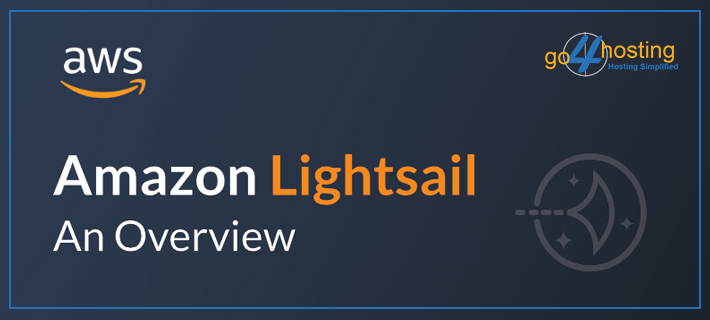Amazon Lightsail A Powerful Virtual Server

What makes Amazon Lightsail popular is the fact that it can offer you flat rate low-cost plans for cloud hosting solutions. The public cloud may have grown into the best solution for running diverse workloads but there are many businesses that are still not yet ready for the cloud. These organizations prefer to keep their data on-site. Sometimes, because of the security concerns that drive them to stick to on-premise data centers; or several other reasons. There are still others who choose to run workloads on-site because of the cost involved.
Inevitably, numerous businesses might resist outsourcing workloads, favoring in-house setups for hosting, avoiding additional costs. However, on-premise infrastructures become outdated over time. This prompts a choice: migrate to a cloud setup or reinvest in updated infrastructure. Considering factors like AWS Lightsail pricing becomes pivotal in this decision-making process.

There is often the lack of predictability of costs which may become a roadblock when it comes to running workloads on the cloud. For instance, there have been many instances of cloud fees shooting up and down because of resource usage spikes. The biggest selling point for cloud hosting india vendors is the low-cost advantage that every cloud expects to offer. But this will not appeal to an organization that does not even know what the services are going to cost them every month. Amazon Web Services or AWS has made an effort to resolve this issue. They have come up with a service called the Amazon Lightsail which is designed for making costs of conducting business on a cloud more predictable.
How does the Amazon Lightsail fare in comparison to the EC2?
Amazon Lightsail web hosting operates similarly to Elastic Compute Cloud (EC2), allowing VM hosting in the cloud. Lightsail stands out due to its cost-effectiveness with flat-rate prices, contrasting EC2’s variable pricing. While Lightsail’s affordability might imply replacing EC2, certain EC2 workloads may not transition due to limitations, such as OS support. Unlike EC2’s OS variety, Lightsail only supports Ubuntu and Amazon Linux, limiting Windows OS use. This comparison sheds light on Amazon Lightsail pricing advantages over EC2
The biggest reason to choose the Lightsail is its affordability; AWS Lightsail pricing starts around $5 every month and the first month is free of cost. The other plans which are more featurely-rich are priced slightly higher and such plans can offer you enough resources to support demanding apps and high-traffic sites. While the most basic plans are perfect for those starting out, the most feature-rich ones are best suited for medium to high businesses.
The comparison between Lightsail and EC2 extends to hardware support, a crucial aspect to consider. Lightsail offers multiple hardware options, akin to EC2, providing VPS options like single cores, 20GB SSD, 512MB RAM, and 1TB transfer for just $3.50 a month. AWS also furnishes Lightsail images, accommodating various Bitnami applications such as Magento, Drupal, and WordPress, elevating the overall Lightsail experience and making it competitive in terms of AWS Lightsail pricing.
The Lightsail instances may be promoted as flat-rate VPS offerings under Amazon Lightsail pricing. However, additional charges can arise, such as obtaining static IP addresses without attaching them to the instance. While Lightsail doesn’t charge for static IP addresses in use, a half-cent fee per hour applies when these IPs are unattached.
In some scenarios, additional costs may arise, such as when surpassing instance data transfer caps. However, understanding this aspect of data transfer is crucial. Notably, Amazon Lightsail exempts charges for inbound data transfer even if limits are exceeded. Also, outbound data transfers meeting specific criteria, using the instance’s private IP and directed to another Lightsail instance, don’t count toward these limits. If these conditions don’t meet, Amazon Lightsail pricing calculates data transfers against the data transfer caps.
The base subscription rate for Lightsail does not cover an important feature: the snapshot. So, AWS will charge you $0.05 for every gigabyte every time you create one snapshot of any Lightsail instance.
To sum up, Amazon Lightsail will work best for businesses that are keen to deploy servers without having to go through the trouble of working out the prices, configurations, and management details of deployments. AWS calculator offers customers many options where you can calculate a predictable monthly cost. Lightsail however will not be suitable for applications that need a configurable environment and consistently high CPU, like analytics and video encoding. The menu interface enables the deployment of servers within minutes. Lightsail will also offer many pre-built virtual images. The developers can select packages preconfigured with domain name management, SSD storage, and static IP addresses. They can also install and configure Lightsail for popular applications like Joomla, Drupal, and WordPress.
Conclusion: –
In theory, Lightsail will help businesses deploy an instance and even save money even when Lightsail is not running. But, in practice, you will be charged by AWS for an instance even when it does not run. In order to stop this from happening, the developer will have to back up this instance and delete it from the Lightsail. However, the organization will still have to pay fees to retain the static IP address.





